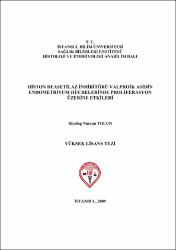| dc.contributor.advisor | Koyutürk, Meral | en_US |
| dc.contributor.author | Tolun, Nurcan | |
| dc.date.accessioned | 2014-06-20T14:16:34Z | |
| dc.date.available | 2014-06-20T14:16:34Z | |
| dc.date.issued | 2009 | |
| dc.date.submitted | 2009 | |
| dc.identifier.citation | Tolun, Nurcan. (2009). Histon Deasetilaz İnhibitörü Valproik Asidin Endometriyum Hücrelerinde Proliferasyon Üzerine Etkileri. Yayımlanmamış yüksek lisans tezi. İstanbul : İstanbul Bilim Üniversitesi, Sağlık Bilimleri Enstitüsü. | en_US |
| dc.identifier.uri | https://hdl.handle.net/11446/172 | en_US |
| dc.description | İstanbul Bilim Üniversitesi, Sağlık Bilimleri Enstitüsü, Histoloji ve Embriyoloji Anabilim Dalı Yüksek Lisans Programı. | en_US |
| dc.description.abstract | Bu çalışmada in-vitro endometriyum hücre modeli kullanılarak, histon deasetilaz inhibitörü valproik asidin (VAP), menstrual siklusun östrojen tarafından stimüle edilen proliferasyon evresindeki olası etkileri immünositokimyasal olarak incelendi.
VAP’ın hücre proliferasyonu üzerine olan etkilerinin incelenebilmesi ve karşılaştırma yapılabilmesi amacıyla ilaç, tek başına ya da 17-β-östradiol ile kombine edilerek çeşitli dozlarda deney gruplarına uygulandı. Hücre canlılığı tripan mavisi kullanılarak değerlendirildi. Konsantrasyona bağlı olarak canlı hücre yüzdesinin azaldığı izlendi. S fazındaki Ishikawa hücreleri, anti-BrdU antikoruyla işaretlendi. Deney gruplarında, hücre siklusunun önemli düzenleyicileri olan p21 ve p53 proteinlerinin ekspresyon düzeyleri incelendi. 17-β-östradiolün hücre proliferasyonunu artırdığı gözlemlendi. Konsantrasyona bağlı olarak VAP uygulamasının hücre proliferasyonunu azalttığı ve/veya inhibe ettiği gözlendi. 20 mM VAP uygulanan deney gruplarında proliferasyon inhibisyonu, p21 ve p53 ekspresyonları üzerinden gerçekleşti. Hücrelerde apopitotik hücre ölümüne özgü morfolojik değişiklikler ve kaspaz-3 ekspresyonu izlendi. 50 mM VAP uygulanan deney gruplarında ise hücre proliferasyonunun inhibe olduğu; ancak p21 ve p53 protein ekspresyonlarının gerçekleşmediği gözlendi. Yüksek dozda, morfolojik apopitotik değişiklikler ve kaspaz-3 aktivasyonu izlenmedi.
Yaptığımız çalışmalarda histon deasetilaz inhibitörü VAP’ın, endometriyum hücre proliferasyonunu engellediği ve hücre ölümüne yol açtığı gösterildi. Elde edilen bulgular doğrultusunda VAP’ın, endometriyal kanserler ve endometriozis gibi endometriyum-kaynaklı hastalıkların tedavisinde kullanılabilme potansiyeline sahip terapötik bir ajan olarak değerlendirilebileceği sonucuna varılmıştır. | en_US |
| dc.description.abstract | In this research, we investigated the possible effects of histone deacetylase inhibitor valproic acid (VAP) during the proliferative phase of the mestrual cycle that is stimulated by estrogen, on an in-vitro endometrium model, by using immunocytochemistry method.
In order to observe the effects of VAP on cell proliferation, we treated the cells with different concentrations of VAP alone, or in combination with 17-β-estradiol. Cell viability was determined by trypan blue dye exclusion. A decrease in cell viability percentage was determined that it was due to different concentrations. The S-phased Ishikawa cells were visualized by staining with anti-Bromodeoxyuridine (BrdU) antibody. Significant cell cycle regulatory proteins p21 and p53 expressions were analyzed. It was observed that 17-β-estradiol increased the cell proliferation. VAP treatment decreased and/or inhibited the proliferation rates of the cells in a dose-dependent manner. 20 mM VAP treatment inhibited the cell proliferation and induced p21 and p53 protein expressions. The characteristic morphological changes and caspase-3 expression of apoptotic cell death were also observed at this concentration. It was determined that 50 mM VAP treatment inhibited the cell proliferation but p21 and p53 protein expressions did not occur. In addition, no morphological features of apoptosis or caspase-3 expression were observed at high dose.
The present data has shown us that HDAC inhibitor VAP can inhibit the endometrial cell proliferation and induce cell death. In the light of these findings, the identification of VAP suggests a potential role to be used as a therapeutic agent in the treatment of endometrium-derived diseases; such as endometrial neoplasms or endometriosis. | en_US |
| dc.language.iso | tur | en_US |
| dc.publisher | İstanbul Bilim Üniversitesi, Sağlık Bilimleri Enstitüsü. | en_US |
| dc.rights | info:eu-repo/semantics/openAccess | en_US |
| dc.subject | valproik asit | en_US |
| dc.subject | östradiol | en_US |
| dc.subject | östrojenler | en_US |
| dc.subject | valproic acid | en_US |
| dc.subject | estradiol | en_US |
| dc.subject | estrogens | en_US |
| dc.title | Histon deasetilaz inhibitörü valproik asidin endometriyum hücrelerinde proliferasyon üzerine etkileri | en_US |
| dc.title.alternative | The effects of histone deacetylase inhibitor valproic acid on endometrial cell proliferation | en_US |
| dc.type | masterThesis | en_US |
| dc.department | DBÜ, Sağlık Bilimleri Enstitüsü, Histoloji ve Embriyoloji Ana Bilim Dalı | en_US |
| dc.contributor.authorID | TR140953 | en_US |
| dc.relation.publicationcategory | Tez | en_US |
| dc.identifier.yoktezid | 242849 | en_US |


















